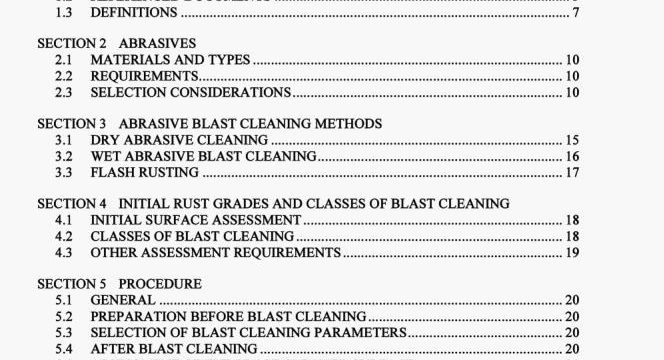AS 1627.4-2005 pdf download.Metal finishing—Preparation and pretreatment of surfaces Part 4: Abrasive blast cleaning of steel.
3.1 DRY ABRASIVE CLEANING
3.1.1 Compressed air abrasive blast cleaning
Compressed air abrasive blast cleaning is carried out by incorporating an abrasive or abrasive mixture into an air stream, and directing the resulting high velocity air/abrasive flow through a nozzle onto the work piece. The abrasive is usually injected into the air stream from a pressurized container. The method is suitable for cleaning work of all types, including large structures having variable rust grades, and may be used either continuously or intermittently.
The system can be used in enclosed plants, rooms or cabinets, or on-site, and is able to be designed so that abrasive can be recovered, cleaned and recycled. This method may give rise to dust when used in open areas and its use may be restricted by environment or legislative requirements, in which case dust suppression or collection facilities are required. Compressed air abrasive blast cleaning will not remove oil, grease and related contamination, and will not remove chemicals such as soluble salts. Additional treatment is required if removal of such contaminants is necessary.
NOTE: For sweep (brush) blasting see Appendix D.
3.1.2 Vacuum or suction head abrasive blast cleaning
Vacuum or suction head abrasive blast cleaning is similar to compressed air abrasive blast cleaning, but with a blasting nozzle enclosed in a suction head which is sealed to the metal surface and collects spent abrasive and contaminants. Alternatively, the abrasive air stream may be held on to the surface by negative pressure at the suction head. The method is particularly suitable for localized cleaning, and where the dust and debris resulting from unconfmed compressed air blast cleaning techniques are unacceptable.
The production rate is slower and generally less effective than other blast cleaning methods, as the velocity of the abrasive is substantially below that of the other methods. It is not recognized as being suitable for cleaning heavily corroded steel, and is not applicable for irregular shapes, due to the necessity of close sealing to the surface, and difficulties in handling the equipment. As with compressed air abrasive blasting, it will not remove oil and grease or chemicals, such as soluble salts.
3.1.3 Centrifugal abrasive blast cleaning
Centrifugal abrasive blast cleaning is carried out in enclosed plants or mobile units in which the abrasive is fed to rotating wheels or impellers positioned to propel the abrasive evenly, and at high velocity, onto the surface to be cleaned.
The method is generally confined to a fixed abrasive blast cleaning station, for continuous blast cleaning of plates, pipes and of structural members before erection. In most cases, the abrasive is circulated in a closed system; the work pieces are either fed through these plants or rotated within them. In certain cases, the equipment may be mobile and may be used for cleaning large uninterrupted surfaces such as ship’s decks, tank floors. The centrifugal abrasive blast cleaning equipment has to be carefully designed to achieve an even blast over the total surface area. The method is limited to repetitive work associated with high volume throughput or continuous operation. Surfaces inaccessible by this method are usually blast cleaned manually. Centrifugal abrasive blasting will not remove oil and grease, nor chemicals such as soluble salts.
3.2 WET ABRASIVE BLAST CLEANING
3.2.1 General
Wet blasting, using a combination of water and abrasive to clean the surface, is usually used for maintenance rather than new work. It has the following advantages over dry abrasive blasting:
(a) It can reduce the level of dust.
(b) It can more readily remove soluble salts and other soluble contamination from a pitted surface.
The disadvantages include:
(I) The surface remains wet, and will flash rust if steps are not taken to prevent it.
(ii) A wet slurry tends to build up on the work surface and surrounds which can be difficult to remove.
(iii) The operation is usually slower than dry blasting.
(iv) It is difficult for operators to work in wet conditions and monitor levels of cleanliness.
(v) Wet blast cleaning cannot be used where water presents a hazard.AS 1627.4-2005 pdf download.Metal finishing—Preparation and pretreatment of surfaces
Metal finishing—Preparation and pretreatment of surfaces
